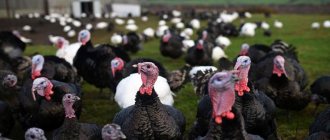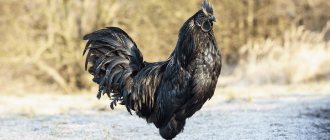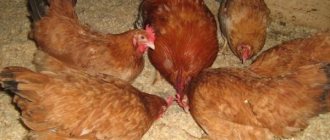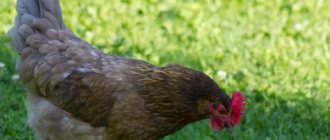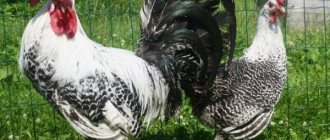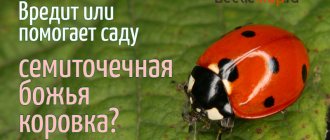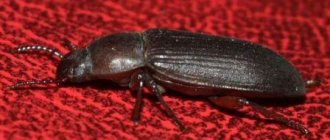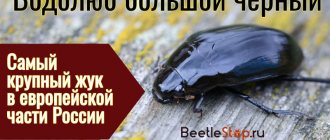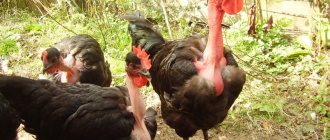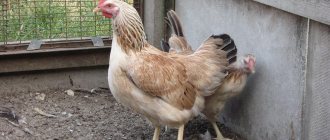The Loman chicken breed was born back in 1970 thanks to the efforts of the German company Loman Tirtsucht. Breeders set themselves the task of developing a very productive hybrid that could outdo all existing laying hens on the planet. At that time, Leghorns were considered the most productive breed. They were crossed with other breeds to obtain this hybrid.
At the moment, Lomans are presented in two subspecies: Brown (brown) and White (also often called White) - white. It is the white variety of this cross that we will talk about today.
In the publication you will find a detailed description of the cross, see photos of white beauties, as well as reviews from farmers who were lucky enough to have this hybrid in their backyard.
Breed characteristics
The average weight of adult representatives of Loman White reaches 2.2 kg. The chickens of this cross are quite small, very rarely gaining more than 1.7 kg. The main value of this hybrid is its high egg production. It is worth mentioning that White’s productivity is stable and can only decline during the molting period, but this is a characteristic feature of each breed of laying hen.
The first thing that catches your eye when meeting this poultry is its very white plumage. This is the merit of one of the progenitors - the Leghorn breed. The feathers fit very tightly to the body, without creating an air “cushion”. It is worth noting that the feathers are very hard.
The tail is located at a right angle, both in a cockerel and in a hen. But the hen, naturally, has a slightly shorter tail. The wings are relatively small, proportional in length to the body. The body itself is trapezoidal, like most other laying hens. Cockerels have pronounced breasts, while hens have a clearly visible large belly.
The bird's legs are elongated and bright yellow. On the head there is a bright red comb, with the same bright red earrings. Males have a more developed comb than females. Usually the comb is erect, but there are White specimens in which it is skewed to one side.
Diseases
The cross does not have any typical or chronic diseases.
- Parasites
- Infectious
- Other
Chicken mite
How to treat a chicken coop and how to treat a bird. Description of drugs and methods of control
Read
Coccidiosis
Thirst, loss of appetite, swelling, bloody droppings, anemia, weakness, poor coordination
Read
Ascariasis
Loss of appetite, liquid droppings, pale mucous membranes of the comb, limbs, ruffled plumage, lethargy, vomiting
Read
Amidostomiasis
Symptoms of the acute form: apathy, general weakness, decreased or lack of appetite, breathing problems, unsteady gait, retarded growth and development
Read
Prostagonymosis
Decreased mobility, loss of appetite, unsteady gait, bloating, fever, impaired egg laying, exhaustion
Read
Knemidocoptic mange (“lime foot”)
Acute symptoms: light gray bumps appear on the legs, the bird limps and stands on one leg, the cloaca and joints become inflamed, the beak is deformed
Read
Heteracidosis
Symptoms: indigestion, diarrhea, loss of appetite, lethargy, decreased egg production, retarded growth and development
Read
Trichomoniasis
Symptoms of the acute form: fever, depression and loss of appetite, diarrhea with gas bubbles and a putrid odor, enlarged goiter, difficulty breathing and swallowing
Read
Pullorosis (typhoid fever, salmonellosis)
Weakness, lack of coordination, drooping eyelids, difficulty breathing, lack of appetite, indigestion
Read
Colibacillosis
Lack of appetite, thirst, sudden increase in temperature, pale scallops, diarrhea
Read
Pasteurellosis
Fever, foamy mucus, change in stool color, refusal to feed, thirst, lethargy, wheezing, heavy breathing
Read
Marek's disease
Paralysis of the limbs, difficulty breathing, severe exhaustion and loss of strength, refusal of food and water, pallor of the scallop
Read
Gumboro disease
Diarrhea, loss of appetite, trembling legs and head, sudden death
Read
Laryngotracheitis
Weakness, swelling of the neck, difficulty breathing, cough, wheezing, blood clots in the mucus released when coughing, lack of appetite, indigestion
Read
Bird flu
Refusal to eat, anorexia, diarrhea, purulent discharge, hoarse breathing, greenish-brown droppings, seizures, darkening of the ridge
Read
Newcastle disease
Decreased appetite, fever, respiratory distress, immobility, conjunctivitis, bloody diarrhea
Read
Apteriosis
Complete or partial absence of plumage, loss of tail feathers, broken embryonic fuzz in young animals, delayed growth of plumage, pecking
Read
Pterophagy
Plucking and eating feathers. What is the reason, why does it require urgent intervention and how to prevent the disease?
Read
Yolk peritonitis
Symptoms of the acute form: loss of appetite, gray-green color of feces, sudden drop in egg production, calcareous deposits on the shell, bluish tint and baldness of the abdominal skin
Read
Cloacite
Symptoms: depressed state, decreased appetite, weight loss, increased need for water, loss of plumage, inflammation and bulging of the cloaca, the presence of ulcers on the mucous membrane, decreased egg production
Read
Character of the cross
Loman White is one of the calmest crosses. Whites are rather melancholy individuals who very rarely enter into conflict. Roosters are not characterized by aggressive behavior, and they not only do not provoke conflicts, but also try to avoid provocations from other roosters, animals or people.
This hybrid can be safely kept with other breeds of chickens without fear that conflicts will arise between different families.
In this case, you need to take into account the fact that this is a fairly active bird and it will be very crowded in a small chicken coop, not to mention an ordinary cage. Therefore, in order for the Whites to feel good, they need to organize a large walking yard.
Exterior standard
The Loman White chicken breed fits favorably into private households, thanks to its pleasant appearance, the description and photo of which includes some distinctive features inherent in the standard:
- the egg direction of the breed line influenced the formation of the constitution of birds, whose physique is compact and resembles a trapezoid, but with a narrow and unpronounced chest and belly, which is more typical for meat representatives,
- small head with bright crest and lobes, which contrast most noticeably against the background of white plumage,
- Some laying hens are distinguished by combs that fall to one side, which is not a disqualifying sign; roosters have large combs ending in deep teeth.
Due to their small size and long legs, white chickens look quite athletic.
The snow-white plumage of Loman White chickens can be assessed from the photo.
Puberty and productivity
The productivity of this cross is considered one of the best among laying hens. White hens are capable of producing eggs every day, no matter what time of year it is.
Sexual maturity of chickens occurs at 4 months. It is during this period that crosses can lay their first clutch. Productivity increases with age.
Maximum egg production lasts no more than 80 weeks (560 days). On poultry farms this cross is not kept for longer than 560 days, but at home the birds are kept for 2-3 years.
As noted earlier, during molting a significant drop in productivity is possible. During this period, it is necessary to take care of the correct diet of the bird. It must be provided with the proper amount of calcium, protein and vitamins. This will allow you to recover faster and return to your previous productivity levels.
Advantages and disadvantages of this cross
This cross is still one of the most popular in the Russian Federation. This popularity is due to a number of advantages, among which it is worth mentioning:
- This is not a very voracious bird, making its maintenance rational.
- They ripen very quickly. They can lay eggs as early as 4 months of age.
- Young animals have high survival rates.
- Quite an easy-to-care poultry.
- Adapt well to different climatic conditions.
- They have high egg production rates. One laying hen can produce about 350 eggs per year.
- The eggs are very large, up to 70 grams.
Naturally, like any other poultry, Loman White has its drawbacks. Among the main ones:
- Suppressed maternal instinct. Like most crosses, chickens have one purpose - to lay eggs. And the likelihood that some laying hen will want to become a hen is practically reduced to zero.
- This hybrid has a fairly short period of maximum productivity.
Economic benefits when breeding
Poultry farms in Russia and Europe buy Loman White White chickens because of their high productivity indicators:
- Laying hens of this cross produce a record number (from 330 to 340) eggs per year,
- The chicken begins to lay eggs when it reaches four months of age, with rare exceptions - a little later,
- eggs from Lomanov hens are large (60-65 g each), with a white shell.
Due to the fact that representatives of the Loman White breed were bred primarily for egg production, their meat characteristics are lower than those of other chicken breeds:
- the weight of a rooster usually does not exceed 2.0 kg,
- The average weight of a chicken is up to 1.5 kg.
Nevertheless, positive reviews, income from the number of eggs received annually from laying hens significantly exceeds the financial resources spent on maintaining and caring for the birds, which makes Loman breeding economically profitable.
Maintenance and care
Caring for poultry is not that difficult. It is enough just to follow a number of simple rules:
- The temperature in the chicken coop should be between +23-25 degrees Celsius. Chickens, of course, can tolerate lower temperatures, down to +5 degrees, but this will negatively affect their egg production.
- It is advisable to place a good layer of bedding on the floor of the chicken coop. The bedding can be peat, straw or hay. The approximate thickness of the litter is 15 cm.
- Ideal conditions for chickens are if the chicken coop has 1 m2 of space for 2 chickens. These are ideal conditions. Acceptable, which most farmers adhere to, is 4 chickens per 1 m2.
- The premises must be kept clean at all times. The litter is removed every 3 months, drinking bowls and feeders are cleaned as they become dirty. Disinfection must be carried out at least once every 6 months. Otherwise, a lot of fleas will settle in the chicken coop, which will bite not only the bird, but also the people who come for the eggs.
- If possible, it is necessary to install a hood that will protect the room from dampness and unpleasant odors.
- The ideal daylight hours for chickens is 13 hours. In winter, when the sun sets early, fluorescent lamps are used.
- It is best to place feeders and drinkers along the wall. This will protect them from tipping over. Also, it is advisable to install a net on the feeder, since birds very often rummage through the feed and scatter it throughout the room. The mesh will make it easy for chickens to get food, and at the same time protect it from the bird’s “bad” habits.
- The chicken coop should also have perches. They are placed at a height of 50-60 cm from the floor. An average of 40 cm per roost per hen is allocated.
Feeding
Feeding poultry is the most important process that has the greatest impact on its productivity. The number of eggs that a laying hen will produce depends on whether the Loman White diet is correctly formulated.
Feeding tips:
- In the first weeks of their life, chickens need to be fed with mixed feed, that is, a dry grain mixture. You should refrain from homemade recipes at this time.
- When the chicks are 21 days old, you can add fresh vegetables and fruits to the feeders.
- Also, if possible, you can start giving fresh grass.
- The approximate norm for adult laying hens is 120 grams per individual.
- During the molting period of birds, emphasis should be placed on vitamins and mineral supplements.
- From time to time it is necessary to give the chickens mash. It is prepared either with boiled water or using broth. Various cereals and vegetables (including potato peelings) are added to the mash. Also, it is imperative to add table salt and bone meal to the mash.
Incubation
Crosses are bred exclusively in an incubator. The conditions are standard and have no special features.
Table of temperature and humidity modes
| Period |
